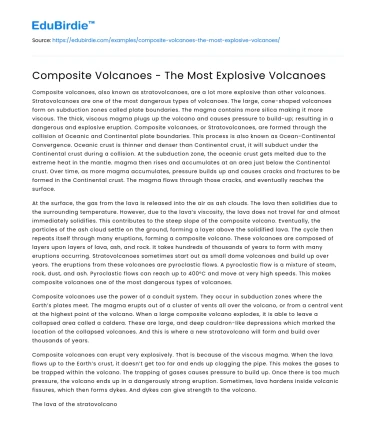Composite volcanoes, also known as stratovolcanoes, are a lot more explosive than other volcanoes. Stratovolcanoes are one of the most dangerous types of volcanoes. The large, cone-shaped volcanoes form on subduction zones called plate boundaries. The magma contains more silica making it more viscous. The thick, viscous magma plugs up the volcano and causes pressure to build-up; resulting in a dangerous and explosive eruption. Composite volcanoes, or Stratovolcanoes, are formed through the collision of Oceanic and Continental plate boundaries. This process is also known as Ocean-Continental Convergence. Oceanic crust is thinner and denser than Continental crust, it will subduct under the Continental crust during a collision. At the subduction zone, the oceanic crust gets melted due to the extreme heat in the mantle. magma then rises and accumulates at an area just below the Continental crust. Over time, as more magma accumulates, pressure builds up and causes cracks and fractures to be formed in the Continental crust. The magma flows through those cracks, and eventually reaches the surface.
At the surface, the gas from the lava is released into the air as ash clouds. The lava then solidifies due to the surrounding temperature. However, due to the lava’s viscosity, the lava does not travel far and almost immediately solidifies. This contributes to the steep slope of the composite volcano. Eventually, the particles of the ash cloud settle on the ground, forming a layer above the solidified lava. The cycle then repeats itself through many eruptions, forming a composite volcano. These volcanoes are composed of layers upon layers of lava, ash, and rock. It takes hundreds of thousands of years to form with many eruptions occurring. Stratovolcanoes sometimes start out as small dome volcanoes and build up over years. The eruptions from these volcanoes are pyroclastic flows. A pyroclastic flow is a mixture of steam, rock, dust, and ash. Pyroclastic flows can reach up to 400°C and move at very high speeds. This makes composite volcanoes one of the most dangerous types of volcanoes.
Composite volcanoes use the power of a conduit system. They occur in subduction zones where the Earth’s plates meet. The magma erupts out of a cluster of vents all over the volcano, or from a central vent at the highest point of the volcano. When a large composite volcano explodes, it is able to leave a collapsed area called a caldera. These are large, and deep cauldron-like depressions which marked the location of the collapsed volcanoes. And this is where a new stratovolcano will form and build over thousands of years.
Composite volcanoes can erupt very explosively. That is because of the viscous magma. When the lava flows up to the Earth’s crust, it doesn’t get too far and ends up clogging the pipe. This makes the gases to be trapped within the volcano. The trapping of gases causes pressure to build up. Once there is too much pressure, the volcano ends up in a dangerously strong eruption. Sometimes, lava hardens inside volcanic fissures, which then forms dykes. And dykes can give strength to the volcano.
The lava of the stratovolcano is also very brittle. Composite volcanoes are very steep, tall, and symmetrical. The accumulation of too many materials could cause the slopes of the volcano may become very unstable. The unstable walls of the stratovolcano can then collapse under its own weight.






 Stuck on your essay?
Stuck on your essay?

